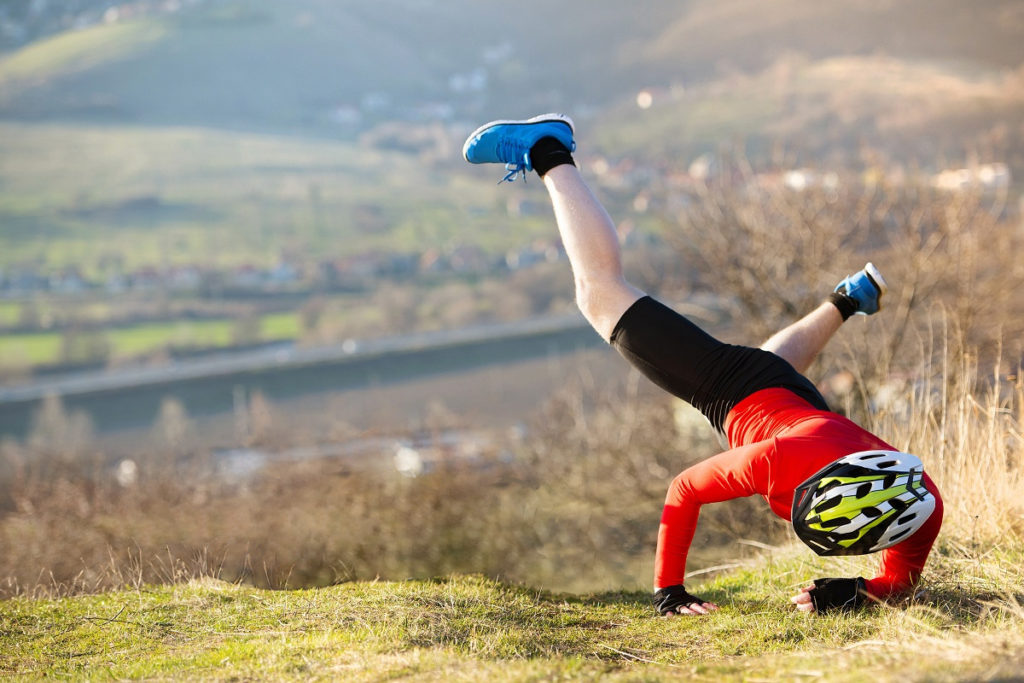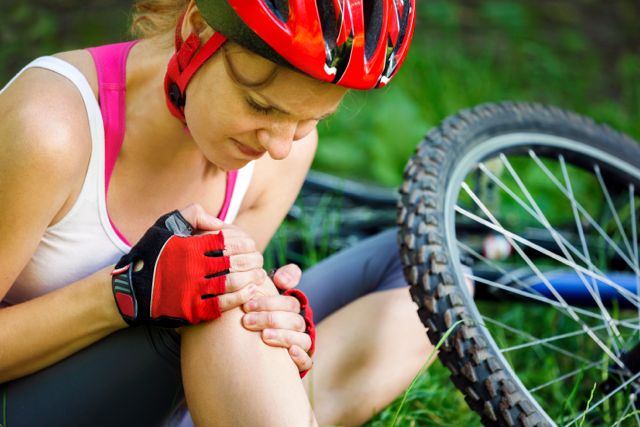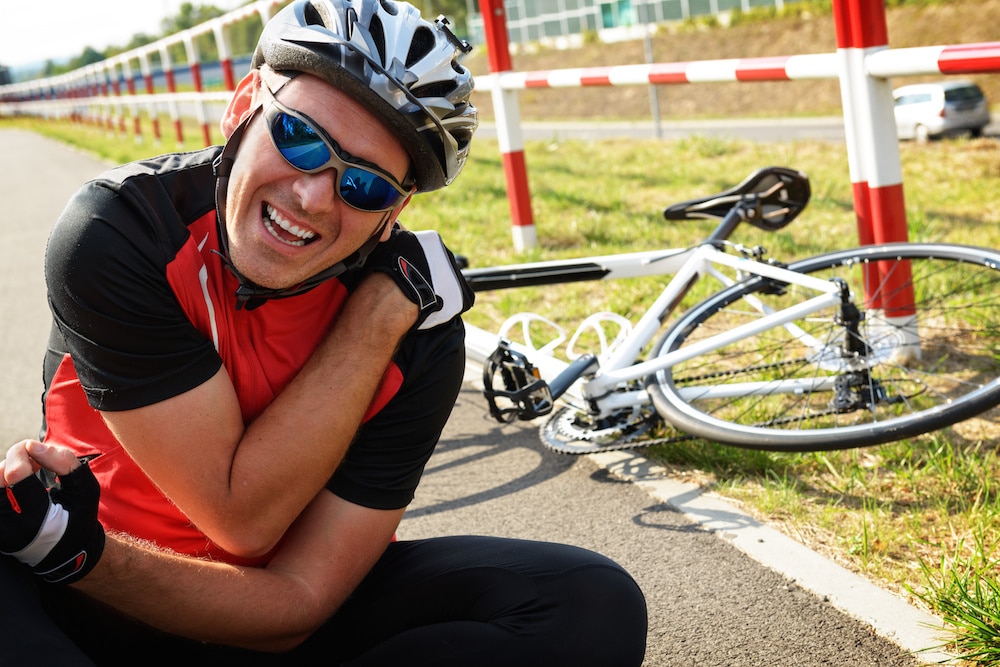Top 5 Cycling Injuries And How To Avoid Them
Most people that are involved in a cycling accident could have avoided being seriously hurt. Unfortunately a great deal of cycling accidents are survivable, but the injuries sustained happen after the fact. This is due to improper maintenance of bikes and not using basic prevention techniques available to all road cyclists.

The majority of road cycling injuries are preventable, but many cyclists do not take the proper precautions to do so. Today more than ever, modern cyclists have gear and equipment that should avoid injury from cycling accidents and other painful injuries. This article is going to explain the top 5 road cycling injuries and discuss ways to avoid and prevent them.
If you follow these basic guidelines, you should spend many happy hours on the road without getting hurt.
Biking Lower Back Pain
The most common type of cycling related pains are in the lower back. These are caused by the repeated and prolonged holding positions that are created when cycling. In order to have proper aerodynamic performance and optimum speed generated by pedal force, it takes a great deal of exertion on the part of the lower back. This can lead to lower back pain, herniated lumbar discs or nerve root oping nets in very rare cases.
In order to prevent lower back pain problems, riders need to follow some basic riding guidelines. The most important thing is having your bike set up correctly, so you are not hunched over or reaching too far to steer while riding. It is equally important to be sure that you are riding a bike that is both age and size appropriate for your body type. Also it is essential to use warming up exercises before riding any type of cycle, this assists the muscles and helps prevent spinal problems or injuries to the lower limbs. Don’t forget these important lower back pain prevention tips.

Knee Cycling Pain
Another common cycling problem is knee pain. This often happens to new and ambitious cyclists that over work the knees on the road. This is very easy to do, so new cyclists should try to take it easy and not overwork their bodies, until they have built up a reasonable level of endurance. There are also number of things to consider, if you want to prevent potential knee cycling pain.
Prevention of knee cycling paint isn’t difficult, but it requires some consistency on the part of the cyclist. First keeping your bike well maintained helps prevent most cyclist injuries, especially those related to the knee or joints. Next keeping a good posture is necessary to avoid most knee cycling injuries, your trainer or physician can help determine if your posture is imbalanced. Finally using warming and cooling compounds can help relieve knee cycling pain, so that you can enjoy riding your bike for exercise.
AC Joint Sprain
Acromioclavicular or AC joint sprain happens when the the stabilizing ligaments of the shoulder complex become damaged. The AC joint is one part of the entire shoulder system. It primarily consists of the collar bone which is joined to the frontal shoulder blades and is held together with very strong ligament muscles. This type of injury only occurs when great force sprains the AC joint, such as falling or lunging forward due to colliding with an obstacle either on or off road.

The simplest answer to avoiding AC joint sprains is not falling. AC joint sprains happen when the wrist and arms are forced to a stopping position, then this forced position causes the shoulders to take on the impact. Such cycling accidents cannot always be avoided, so make sure your road bike is in good condition. Regular maintenance is essential to avoid having biking injuries of this sort.
Cuts, Burns and Grazes
These three types of injuries occur most often, when a road cyclist falls to the ground hard. Although professional or competitive cyclists can suffer these or friction pains, as part of regular road or sports cycling. Another common type of cuts, burns and grazes occur with the seat rubbing against the cyclist’s legs, groin or other areas. Such injuries are usually not permanent, but they can be painful.
The easiest way to avoid cuts, burns and grazes is to concentrate on your riding. There is no place for daydreaming or looking around while cycling. You must stay focused on riding your road bike and staying on it. Some saddle sore injuries can be prevented with an upgraded and more comfortable seat. Make sure your road cycle has sufficient padding and is positioned at the right angle for your size. If necessary, ice packs can be applied to such injuries after racing or riding.
Foot Numbness
Many road cyclists experience a loss of feeling in their feet, this is called foot numbness. Foot numbness is most common among road cyclists, this is true in any type of weather conditions. The causes of foot numbness is actually wearing shoes that do not fit well. Ill fit footwear squeezes the metatarsal muscles and this makes for uncomfortable riding, but also cyclist foot injuries when the feet become clenched. Ill fit footwear also puts undue pressure on the balls of the feet, this becomes especially aggravated when riding on excessive hills or steep terrain.
The main way to prevent foot numbness is to wear correctly fit shoes. Amateur and professional road cyclists should always have proper footwear. The average cyclist should replace their footwear at least every two months, if not more often. It is also important for active road cyclists to train for their upcoming events, or anything that is out of the normal cycling routine. The feet and body must be made ready to achieve greater feats of road cycling. To avoid cycling injuries, make sure to warm up the muscles with proper stretching. All these things should be considered, when seriously trying to avoid foot injuries and numbness problems.
In conclusion, proper bike maintenance and preparing the body for cycling is the key to safe riding. The vast majority of cycling injuries can be avoided with just these principles in place. Both amateur and professional level road cycling is best done with a regular routine of warming up the muscles. Using proper padding and well maintained bikes will make all road cycling safer for the individual. These are very simple and practical ways to be safe while riding, all year long.
So take it easy and make sure to ride safe, then you will be able to avoid cycling accidents and have fun on your bike. Happy cycling to everyone out there, and remember to always watch the road. Beep beep!
